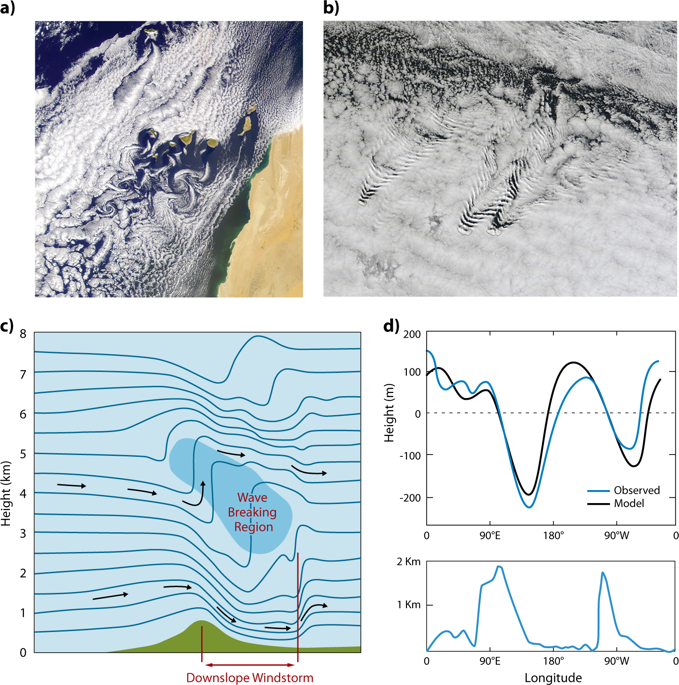npj Climate and Atmospheric Science ( IF 8.5 ) Pub Date : 2019-05-07 , DOI: 10.1038/s41612-019-0065-9 Irina Sandu , Annelize van Niekerk , Theodore G. Shepherd , Simon B. Vosper , Ayrton Zadra , Julio Bacmeister , Anton Beljaars , Andrew R. Brown , Andreas Dörnbrack , Norman McFarlane , Felix Pithan , Gunilla Svensson

|
Some of the largest and most persistent circulation errors in global numerical weather prediction and climate models are attributable to the inadequate representation of the impacts of orography on the atmospheric flow. Existing parametrization approaches attempting to account for unresolved orographic processes, such as turbulent form drag, low-level flow blocking or mountain waves, have been successful to some extent. They capture the basic impacts of the unresolved orography on atmospheric circulation in a qualitatively correct way and have led to significant progress in both numerical weather prediction and climate modelling. These approaches, however, have apparent limitations and inadequacies due to poor observational evidence, insufficient fundamental knowledge and an ambiguous separation between resolved and unresolved orographic scales and between different orographic processes. Numerical weather prediction and climate modelling has advanced to a stage where these inadequacies have become critical and hamper progress by limiting predictive skill on a wide range of spatial and temporal scales. More physically based approaches are needed to quantify the relative importance of apparently disparate orographic processes and to account for their combined effects in a rational and accurate way in numerical models. We argue that, thanks to recent advances, significant progress can be made by combining theoretical approaches with observations, inverse modelling techniques and high-resolution and idealized numerical simulations.
中文翻译:

地形对大规模大气环流的影响
全球数值天气预报和气候模型中某些最大和最持久的环流误差是由于地形学对大气流量影响的表述不足所致。试图解决未解决的地形过程的现有参数化方法在某种程度上已经成功,例如湍流形式的阻力,低水平的流动阻塞或山浪。他们以定性的正确方式捕获了未解决的地形对大气环流的基本影响,并在数值天气预报和气候建模方面取得了重大进展。但是,由于观察证据不足,这些方法存在明显的局限性和不足之处,基本知识不足,已解析和未解析地形比例尺之间以及不同地形过程之间的模棱两可。数值天气预报和气候建模已经发展到一个阶段,这些不足已成为关键问题,并且通过在广泛的时空范围内限制预测技能,从而阻碍了进展。需要更多基于物理的方法来量化表面上完全不同的地形过程的相对重要性,并以合理和准确的方式在数值模型中考虑它们的综合影响。我们认为,由于最近的进展,通过将理论方法与观测,逆建模技术以及高分辨率和理想化的数值模拟相结合,可以取得重大进展。数值天气预报和气候建模已经发展到一个阶段,这些不足已成为关键问题,并且通过在广泛的时空范围内限制预测技能,从而阻碍了进展。需要更多基于物理的方法来量化表面上完全不同的地形过程的相对重要性,并以合理和准确的方式在数值模型中考虑它们的综合影响。我们认为,由于最近的进展,通过将理论方法与观测,逆建模技术以及高分辨率和理想化的数值模拟相结合,可以取得重大进展。数值天气预报和气候建模已经发展到一个阶段,这些不足已成为关键问题,并且通过在广泛的时空范围内限制预测技能,从而阻碍了进展。需要更多基于物理的方法来量化表面上完全不同的地形过程的相对重要性,并以合理和准确的方式在数值模型中考虑它们的综合影响。我们认为,由于最近的进展,通过将理论方法与观测,逆建模技术以及高分辨率和理想化的数值模拟相结合,可以取得重大进展。











































 京公网安备 11010802027423号
京公网安备 11010802027423号